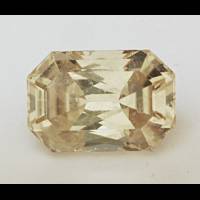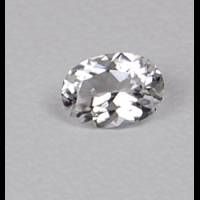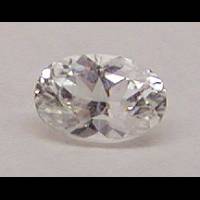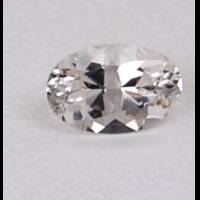Phenakite

Brazil
9.54 carats
© Rarestone.com
Phenakite is mostly water-clear, coloured stones can fade. Phenakite with its hardness, lack of distinct cleavage, rarity and high clarity can make lively interesting gemstones. The cut stones usually have weight of 1 - 2 carats, rarely up to 12 carats.
Phenakite is found predominantly in Russia in association with Alexandrite, in Brazil, in Nigeria, in Burma and in Madagascar.
Phenakite Gemstones by Colour
This table shows the variety of hues this gemstone can be found in. Click on a photo for more information.
Phenakite Gemstones by Size
This table shows distribution of Phenakite gemstone sizes that are listed on this site. This can give a good indication as to the general availability of this gemstone in different sizes.
Contributed photos
Lightest:0.41 cts
Heaviest:9.54 cts
Average:1.99 cts
Total photos:15
Do you have a larger Phenakite? Why not upload a photo?
| General Information | ||||||||||||||||||||||||||||||||||||
|---|---|---|---|---|---|---|---|---|---|---|---|---|---|---|---|---|---|---|---|---|---|---|---|---|---|---|---|---|---|---|---|---|---|---|---|---|
| Chemical Formula |
| |||||||||||||||||||||||||||||||||||
| Phenakite Treatments | ||||||||||||||||||||||||||||||||||||
| Colorless material has been reported to turn a yellow-brown color on irradiation (Pough and Rogers, 1947). One could expect this change to be reversed by heating - Nassau (1984) | ||||||||||||||||||||||||||||||||||||
| Physical Properties of Phenakite | ||||||||||||||||||||||||||||||||||||
| Mohs Hardness | 7.5 to 8, Blue Chart Gem Identification (2010) More from other references | |||||||||||||||||||||||||||||||||||
| Specific Gravity | 2.90 to 2.98, Blue Chart Gem Identification (2010) More from other references | |||||||||||||||||||||||||||||||||||
| Tenacity | Brittle, Gemstones (2009) | |||||||||||||||||||||||||||||||||||
| Cleavage Quality | Good, Gemstones of the world (2001) More from other references | |||||||||||||||||||||||||||||||||||
| Fracture | Conchoidal, Gemstones of the world (2001) | |||||||||||||||||||||||||||||||||||
| Optical Properties of Phenakite | ||||||||||||||||||||||||||||||||||||
| Refractive Index | 1.650 to 1.695, Blue Chart Gem Identification (2010) More from other references | |||||||||||||||||||||||||||||||||||
| Optical Character | Uniaxial/+, Blue Chart Gem Identification (2010) More from other references | |||||||||||||||||||||||||||||||||||
| Birefringence | 0.016, Blue Chart Gem Identification (2010) More from other references | |||||||||||||||||||||||||||||||||||
| Pleochroism | Distinct: colorless - orangy-yellow, Blue Chart Gem Identification (2010) | |||||||||||||||||||||||||||||||||||
| Dispersion | 0.015, Gemstones (2009) | |||||||||||||||||||||||||||||||||||
| Colour | ||||||||||||||||||||||||||||||||||||
| Colour (General) | Colourless, yellowish, pink, greenish blue, Gemmological Tables (2004) More from other references | |||||||||||||||||||||||||||||||||||
| Transparency | Transparent, Gemmological Tables (2004) More from other references | |||||||||||||||||||||||||||||||||||
| Lustre | Vitreous, Gemstones (2009) | |||||||||||||||||||||||||||||||||||
| Fluorescence & other light emissions | ||||||||||||||||||||||||||||||||||||
| Fluorescence (General) | Inert to weak greenish, blue, pink, Blue Chart Gem Identification (2010) More from other references | |||||||||||||||||||||||||||||||||||
| Fluorescence (X-RAY) | Specimens show a distinct blue, Gems, Sixth Edition (2006) | |||||||||||||||||||||||||||||||||||
| Crystallography of Phenakite | ||||||||||||||||||||||||||||||||||||
| Crystal System | Trigonal, Blue Chart Gem Identification (2010) More from other references | |||||||||||||||||||||||||||||||||||
| Habit | Rhombohedral, tabular to prismatic crystals, Gems, Sixth Edition (2006) More from other references | |||||||||||||||||||||||||||||||||||
| Geological Environment | ||||||||||||||||||||||||||||||||||||
| Where found: | Phenakite occurs in granite pegmatites., Gems, Sixth Edition (2006) More from other references | |||||||||||||||||||||||||||||||||||
| Inclusions in Phenakite | ||||||||||||||||||||||||||||||||||||
| (Veils of) 2-phase inclusions, rutile needles - Blue Chart Gem Identification, Herve Nicolas Lazzarelli, 2010, p 4 | ||||||||||||||||||||||||||||||||||||
| Further Information | ||||||||||||||||||||||||||||||||||||
| Mineral information: | Phenakite information at mindat.org | |||||||||||||||||||||||||||||||||||
| Significant Gem Localities | ||||||||||||||||||||||||||||||||||||
| ||||||||||||||||||||||||||||||||||||












